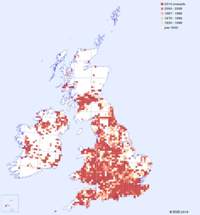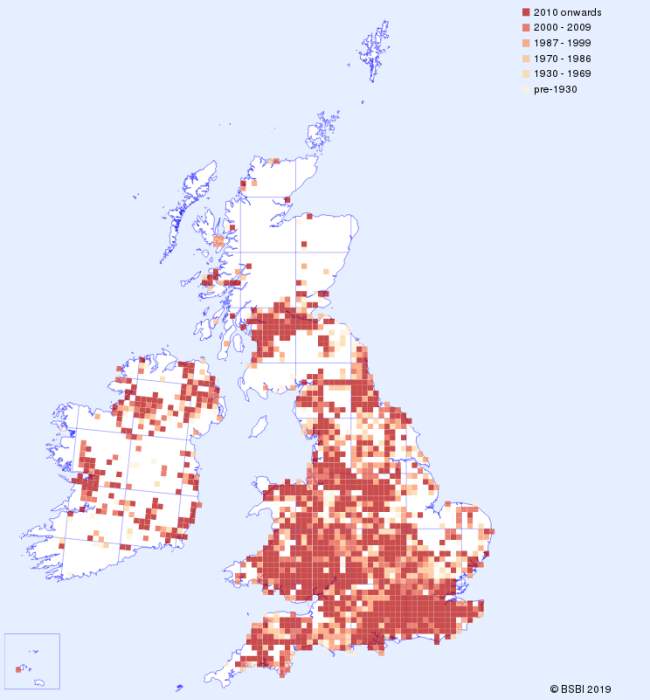The Broad-leaved Helleborine is the commonest and most widespread of the Epipactis species that occur in the British Isles; this is largely due to its tolerance of a variety habitats, provided they are not too acid. Predominantly a woodland orchid and capable of growing in very dark conditions, it is nevertheless most often found on the edges of well-trodden paths and in the lighter, more open areas. Although commonly seen in beechwoods, Epipactis helleborine has also colonised other types of woodland, especially conifer plantations created where native trees have been dug up and replaced by faster-growing cash-crop species. Other places to look for this orchid include shaded roadside verges, riversides, sand-dune systems and disused railways as well as open grasslands on limestone. Broad-leaved Helleborines have also moved into gardens, cemeteries, parkland and golf courses, where Man's activities seem to be no hindrance to it at all! Epipactis helleborine is widespread in England and Wales, extending its range up to the Scottish Border area. Further north, Broad-leaved Helleborine is much more scattered and localised, as also is its distribution in Ireland. This orchid usually flowers between early July and late August, but its flowers can sometimes still be seen in September. Broad-leaved Helleborine is widespread in mainland Europe, from Scandinavia in the north to the Mediterranean region in the south.
| Distribution Map |
Key Features |
 |
Records for the Broad-leaved Helleborine from BSBI are shown on the map with most recent in front. (Hover the mouse over the small map to expand it.)
CLICK HERE to visit the BSBI website page for updated data and
maps with separated data for individual record periods.
|
Plant: 10 to 80 cm tall, frequently to 120cm depending on habitat; stem pale green, washed purple towards the base.
Leaves: 4 to 10 spiral the stem. Lower leaves markedly broad and rounded; upper leaves becoming progressively narrower; green, sometimes pale purple; deeply veined.
Bracts: dark green; narrow with a pointed tip, becoming smaller towards the top of the stem.
Flowers: up to 100 but more commonly to 60 arranged on a one-sided inflorescence which is variably lax to densely-packed depending on the size of the plant and the number of flowers; very variable in colour from yellowish green to quite dark dusky pink. The sepals are oval and taper to a point, often flushed purple. The petals look similar but tend to be paler. The lip is divided into two parts. The hypochile (innermost part) is pale greenish white washed pink-to-purple, and the interior of the shiny 'cup' is variously dark brown or almost purple. The epichile (outermost part) is heart shaped, broad and folded backwards, and it varies in colour from dull green to dull purple; it has two bosses at the tip which can be either smooth or wrinkled. |
Image Gallery for Broad-leaved Helleborine Epipactis helleborine
| Pollination |
Taxonomy & Hybrids |
Broad-leaved Helleborine is pollinated by wasps, particularly those of the Dolichovespula genus. Seed set is good. |
The specific name helleborine means 'like a hellebore' and refers to the similarlty of the leaves of these two plants.
Subspecies: Epipactis helleborine subsp. neerlandica (Dutch Helleborine) is a shorter and more robust plant with a dense spike of dark-pink flowers; it was thought to grow in the dune slacks of South Wales, but genetic studies have revealed that there is very little difference between those plants and other Broad-leaved Helleborines.
Varieties: Epipactis helleborine var. monotropoides lacks chlorophyll and is very pale; it is sometimes referred to as Epipactis helleborine var. albiflora. Epipactis helleborine var. viridiflora lacks anthocyanins and has very pale green flowers with whitish lips; it is rare. Epipactis helleborine var. purpurea is rare and has dark-pink to red flowers.
Young's Helleborine Epipactis youngiana was thought to differ from Broad-leaved Helleborine for a number of reasons including a difference in biological reproduction which has now been widely dismissed. In addition, genetic studies reveal very little difference from normal Broad-leaved Helleborines growing in the same areas. The debate continues!
Hybrids: Epipactis x schmallhausenii is a hybrid with Dark-red Helleborine Epipactis atrorubens. Epipactis helleborine x schulzei is a hybrid with Violet Helleborine Epipactis purpurata. In addition there is an unnamed hybrid between Broad-leaved Helleborine and Dune Helleborine Epipactis dunensis. |
Articles about Broad-leaved Helleborine in JHOS

